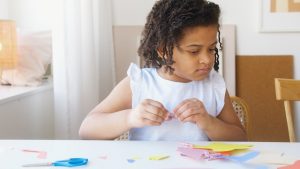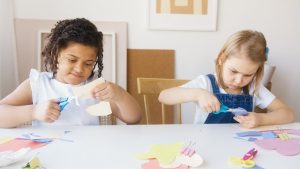Some people ask can you get a diploma from online school? While some other ask can we do online school without laptop. E-learning has stamped its digital footprint in the sand dunes of education. However, as the world progressively swaps chalkboards for screens, an often-overshadowed question emerges: How do we ensure online learning reaches every child, even those without the ‘mighty’ laptop?
The Rich Tapestry of Gadgets
When we peek behind the digital curtain, we find a myriad of devices beyond the familiar laptop. Tablets, smartphones, e-readers, and even some game consoles offer online browsing capabilities. With Wi-Fi or mobile data, these become potent tools for education. Families might not own a laptop but could have a smartphone tucked away. Voilà! That’s a classroom right there.

Public Access Points: The Unsung Heroes
Libraries, community centres, and sometimes even cafes offer computers and internet access for public use. It’s not the ideal daily solution, but in a pinch, these spaces can be invaluable. Setting a routine to visit these places can provide kids with the much-needed screen time to catch up on lessons.
Offline Learning: The Digital Detour
The internet’s magic isn’t confined to real-time interactions. Teachers can tap into the wonder of ‘offline mode’. Downloadable resources, assignments, video lectures, and more can be sent to students. Once downloaded on any device at an internet-accessible location, these resources become accessible from anywhere, anytime, without the need for constant connectivity.
Borrow, Swap, Repeat
Communities are treasure troves of resources and goodwill. Initiating borrowing systems or device-swapping days might just be the golden ticket. It not only ensures every child gets a shot at online learning but also fosters a sense of camaraderie and mutual support among families.
Harnessing the Power of Radio and TV
Think online schooling is all about the web? Think again! Radios and TVs, those relics of the past, have found their second wind in the education sector. Several regions globally have started broadcasting lessons, specially tailored for students without consistent internet or device access. So, all that’s needed is to tune in!
Print It Out Old School Yet Cool
For families with printers, the online world can transition into the tangible. Teachers can email weekly materials, which parents can then print out, transforming the digital into physical learning packs. Not only does this offer flexibility but also the tangible touch of paper might just be the right blend of old-school and contemporary.
Interactive Voice Response (IVR) Systems: No Screen, No Problem!
IVRs are not just customer service tools. They’re interactive systems where students can receive information, lessons, or even quizzes over a simple phone call. Teachers record content, students dial in, listen, and sometimes even interact using their phone keypads.
Peer Learning and Shared Devices
Another strategy is the age-old practice of group study, albeit with a twist. Families who have a device can host mini-classes where two or more kids learn together. It’s collaborative, it’s engaging, and it’s a testament to the adage, ‘Sharing is caring’.
The Role of Schools: Reinventing Resource Allocation
Schools and educational institutions aren’t just brick-and-mortar structures; they’re pillars of support. Recognizing the device deficit, some institutions have initiated loan programs, where devices are loaned to students for a stipulated period, ensuring continuity in learning.
A Hybrid Model: The Best of Both Worlds
Who said online schooling needs to be exclusively online? A hybrid model, a potpourri of face-to-face teaching and digital lessons, might be the middle path. This model can be especially beneficial in areas where the complete online transition is hindered due to a lack of devices.
Education, in essence, is about overcoming barriers. It’s about lighting the lamp of knowledge, even when the winds of adversity blow strong. Online schooling, sans laptops, might seem like threading a needle in the dark. Yet, with innovation, collaboration, and a sprinkle of determination, the seemingly impossible becomes a vivid reality.

Today, as we stand at the crossroads, looking at the expansive horizon of digital education, it’s paramount to remember: Every child has a right to education, laptop or not. The onus is on us, the collective society, to ensure this right isn’t just inked on paper but a tangible, achievable reality.
Gearing Up for E-Learning Without the All-Powerful Laptop
In the age of rapid technological advancement, the idea of online education has seemingly become synonymous with the trusty laptop. But hey, what about those kids who don’t have one? Do they miss the e-learning train? Absolutely not!
- The Versatile World Beyond the Laptop
Let’s take a moment to appreciate the abundance of gadgets that have internet capabilities. There’s the ubiquitous smartphone, many of which now pack as much punch as their larger counterparts. Tablets, with their user-friendly interfaces, are great for interactive educational apps. And don’t get me started on e-readers; they’re not just for reading anymore! - Community Resources: A Lifeline for Many
Before the age of personal laptops and Wi-Fi everywhere, where did most people go to access the internet? Local libraries, of course! They’ve been the unsung heroes for decades and continue to be valuable for kids without personal devices. Additionally, community centres often have computers that can be used by residents. - Sharing is More than Just Caring
In tight-knit communities, it’s not uncommon for neighbours, friends, or relatives to pool resources. Perhaps there’s a family with a computer that’s only used in the evenings. Could it be available for a few hours during the day for a child to attend their online class? Shared schedules and cooperative arrangements could be the ticket for many kids. - The Mighty Radio Waves
Alright, let’s dive into nostalgia for a moment. Remember when radios were the epicentre of entertainment? Well, they’re making a comeback in the education sector. Certain regions globally have leveraged radio stations to broadcast lessons, aiming specifically at kids who might not have a laptop or stable internet. - Printables to the Rescue
Some families might not have a laptop, but they might have a printer. Teachers can send weekly or even daily lessons and worksheets via email. Parents or guardians can then print these out. It might seem like a step backwards, but honestly, who can resist the charm of colourful worksheets? - Talk and Learn: IVR Systems
IVR or Interactive Voice Response systems are no longer just for automated customer service calls. Imagine a scenario where a student calls in, listens to a lesson, interacts using the keypad, and even takes a quiz – all over a phone call! It’s engagement without a screen, and it’s brilliant!

Final Thoughts on the Screenless Schooling
The key takeaway? Online schooling is about adaptability, resilience, and ensuring that no child is left behind, laptop or no laptop. It’s a symphony of using what’s available, thinking outside the ‘laptop’ box, and coming together as a community.
In a world that often feels dominated by screens, perhaps this is a reminder that education, in its truest form, transcends pixels and bytes. It’s an experience, a journey, and most importantly, a right – one that every child, with or without a laptop, deserves to embark on.




